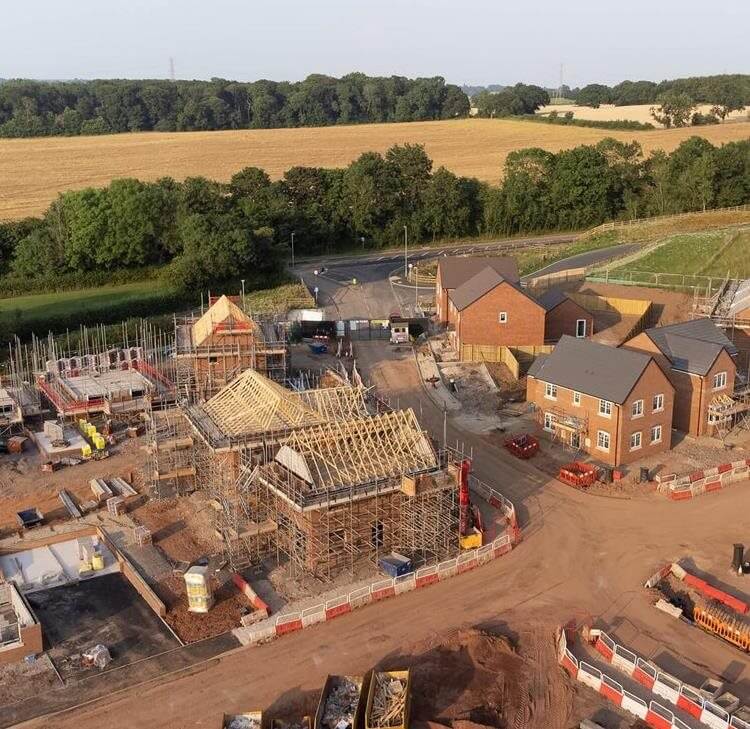On 22 October 2025, the UK Supreme Court handed down its judgment in this case which concerned the application of the Habitats Regulations 2017 to Ramsar Sites and the stage at which the requirement to undertake an appropriate assessment and the "nutrient neutrality" rules apply in the planning process.
Case background: CG Fry and Son Limited v Secretary of State for Housing, Communities and Local Government
On 22 December 2015, Somerset Council granted outline planning permission for a mixed-use development on land at Jurston Farm, near Wellington. The outline planning permission was granted subject to 19 conditions, including a condition requiring a site wide surface water strategy to be prepared, approved and implemented as approved (Condition 4). This condition was discharged on 5 December 2016.
It was intended that the development would come forward in eight phases, and in June 2020 the Council granted reserved matters approval for phase 3 of the development subject to 10 conditions.
The application site is within the catchment area of the River Tone, which feeds into the Somerset Levels and Moors (a Ramsar site).
On 17 August 2020, Natural England published an advice note in respect of development with possible effects on protected sites such as the Ramsar site. Natural England’s advice explained that new residential development within the catchment (or that discharged wastewater via a wastewater treatment works into the catchment) posed a risk that additional phosphates might enter the Ramsar site, resulting in ecological harm through eutrophication and growth of oxygen-depleting micro-organisms.
Natural England advised that these effects ought to be considered in any appropriate assessment, and that all new consent plans and projects should be ‘nutrient neutral’ (i.e., they should not increase nutrients within the Ramsar site).
On 9 June 2021, the developer applied to the Council to discharge a number of the conditions attached to the reserved matters approval for phase 3 of the scheme. The Council maintained, in reliance on Natural England’s advice, that an appropriate assessment needed to be undertaken before any further consent, approval or authorisation for the development could be granted.
On 5 April 2022, the developer appealed to the Secretary of State for non-determination. The Council resisted the appeal. The Council maintained that the application to discharge the conditions ought to be refused because the development could not pass an appropriate assessment because it would add 41.19 kg/year of additional phosphorous.
Natural England had advised that this would have an adverse effect on the integrity of the Ramsar site, and paragraph 181 (now 194(b)) of the National Planning Policy Framework (NPPF) states: “The following should be given the same protection as habitats sites…. (b) listed or proposed Ramsar sites”.
On 24 November 2022, the inspector appointed to determine the appeal by the Secretary of State dismissed the appeal. The inspector agreed with the Council, that the NPPF applied and an appropriate assessment was required.
The developer brought a statutory review in the High Court (case [2023] EWHC 1622 (Admin)), arguing that even if the Ramsar site was subject to the Habitats Regulations, the obligation on the Council to undertake an appropriate assessment only applied when the Council decided whether to grant outline planning permission (Issue 1 before the Supreme Court).
Additionally, the developer argued that the Ramsar site was not caught by the Habitats Regulations as it was not a European Site and the NPPF (a policy, rather than a statute) could not render an immaterial consideration in the decision whether to discharge conditions, material (Issue 2 before the Supreme Court). Sir Ross Cranston, sitting as a High Court judge, rejected both submissions and dismissed the appeal.
An appeal to the Court of Appeal followed (case [2024] EWCA Civ 730), but the Court of Appeal agreed with the High Court judge. The developer appealed to the Supreme Court.
The key legal issues
The Supreme Court considered two fundamental questions:
Issue one: Interpretation of Regulation 63 of Habitats Regulations
The first issue before the Court concerned the interpretation of Regulation 63 of the Conservation of Habitats and Species Regulations 2017, and the correct approach to carrying out appropriate assessments in a multi-stage consenting procedure.
The developer argued that Regulations 63 and 70, when read together, only required an appropriate assessment before planning permission (whether full or in outline) was granted, and that the inspector had erred in law by concluding that an appropriate assessment may be required before a subsequent consent or approval was granted for the same development (such as when reserved matters are approved, or conditions are discharged). The Supreme Court rejected these arguments.
The Court acknowledged that Regulation 70 required, in terms, that an appropriate assessment be undertaken prior to granting planning permission. But the Court rejected the suggestion that an appropriate assessment could not be required prior to granting a subsequent consent or approval for the same development merely because Regulation 70 was silent on this issue.
Regulation 63 was a general provision, that used general language, with general effect. It could not be interpreted as limiting the requirement to undertake an appropriate assessment to the grant of planning permission. The phrase “or other authorisation” undoubtedly brought reserved matters approvals and discharges of planning conditions, within the ambit of the appropriate assessment provisions, and a competent authority may need to make an appropriate assessment before granting such authorisation.
Any other interpretation would defeat the protective purpose of the Habitats Regulations, and the precautionary principle which underpins them.
Interestingly, the Supreme Court specifically held that the purpose of the Habitats Regulations is to implement and follow the Habitats Directive in pursuing the same objective. Brexit has made no difference to this. There is nothing in the Withdrawal Act which affects the application of ordinary domestic law principles of interpretation so far as the Habitats Regulations are concerned.
It was unnecessary to refer to the principles of interpretation in EU law; application of the conventional approach to statutory interpretation in domestic law, which includes the purposive effect, was sufficient.
The Supreme Court dismissed the appeal on issue one.
Issue two: Outline planning permission, reserved matters approval, discharge of conditions and national policy
The second issue before the court concerned the application of national planning policy under the NPPF, in so far as it relates to Ramsar sites, to post-permission planning decisions and approvals.
National planning policy is plainly a “material consideration” when deciding whether to grant planning permission (including outline planning permission). At that stage a developer is asking the planning authority to exercise its discretion to grant permission to proceed with a development and has acquired no right to do so.
However, once planning permission is granted there is a fundamental change in the legal position, in that a grant of planning permission (even in outline) affords a developer the right to develop land in accordance with that permission.
As those rights are conferred by law, they cannot be defeated by mere planning policy (even national planning policy, in the NPPF). The developer may proceed with the development without fear of enforcement action being taken against them. If the planning authority has a change of mind and wishes to revoke or modify the permission, it has to compensate the developer for the loss of its rights (per section 107 of the Town and Country Planning Act 1990).
Reserved matters and conditions stipulate, in legally binding form, the particular matters that a developer needs to address to the satisfaction of the planning authority before they may proceed with their development. However, it is not open to a planning authority to revisit matters which have already been approved in principle at the outline stage.
Neither the Council nor the inspector were permitted to use the fact that the outline planning permission (and the subsequent reserved matters approval) had been granted subject to conditions to require the developer to take additional measures to protect the Ramsar site, when those measures were not required to satisfy the conditions imposed.
The Supreme Court allowed the appeal on this issue.
Implications of the judgment
For Habitats Regulations sites
The Supreme Court has now definitely settled the question of whether a competent authority may make an appropriate assessment before granting any further consent, approval, or other authorisation for a plan or project as part of a multi-stage consenting process. The competent authority undoubtedly may and indeed must where that authority has failed to carry out an adequate assessment when granting the principal, or first, consent, e.g., because of an oversight, misinterpretation of the law, or ignorance or misunderstanding relevant science.
Equally, a competent authority may need to review and revise its earlier assessment when asked to provide a subsequent authorisation for a particular plan or project, e.g., where the condition of the European site has deteriorated since the principal consent was granted, or where the competent authority’s understanding of the plan or project’s impact on the integrity of the site has developed or evolved.
For Ramsar sites
Ramsar sites do not enjoy quite the same protections afforded to European sites by the Habitats Regulations, as Ramsar sites are protected by policy only.
Local planning authorities may not rely on national planning policy to revisit the question of whether development that might harm a Ramsar site is acceptable in principle, once planning permission has been granted.
Local planning authorities may impose conditions requiring mitigation for adverse effects on Ramsar sites, but a developer’s obligations in relation to the Ramsar site are limited by the terms of any conditions so imposed.
However, this judgment will have limited practical application, because the majority of Ramsar sites are also designated as special areas of conservation (SACs) or special protection areas (SPAs) under the Habitats Regulations.
Planning and Infrastructure Bill
The Supreme Court’s judgment naturally begs the question, should all Ramsar sites now be so designated as European sites so that they are adequately protected and the UK can fulfil its obligations under the Ramsar Convention on Wetlands?
In fact, the Government is planning to do exactly that. The Planning and Infrastructure Bill is currently working its way through the Parliamentary procedure. It is currently at the Report Stage in the House of Lords and is likely to achieve Royal Assent early next year.
Schedule 6 to the Bill, if and when enacted, would put Ramsar sites on the same statutory footing as European sites.
Part 3 of the Planning and Infrastructure Bill, if enacted, will also change the way that the environmental impacts of new development are mitigated, by introducing a new levy on developers to contribute to strategic mitigation measures, potentially significantly streamlining assessment and consenting procedures.
Conclusion
While the Supreme Court’s findings in relation to Ramsar sites are likely to have limited application, the Court’s findings on the appropriate assessment of plans and projects under multi-stage consenting regimes will have much broader application.
Appropriate assessment is no longer a “once and done” procedure, completed before the first or principal consent for a new plan or project is granted. Competent authorities may now need to keep their assessments under review, and revise their assessments and mitigation requirements in light of new information or evidence before granting any further consent, approval, or other authorisation for a particular plan or project.
While the duty to make an appropriate assessment arises most often in a development context, it can apply to a wide range of consenting, licensing, and other regulatory decisions.
All public bodies with any regulatory powers ought now to ensure that they understand the implications of this judgment and that they have reviewed their internal policies, procedures, in light of the Court’s findings.
Contact

Rebecca Pritchard
Trainee Solicitor
rebecca.pritchard@brownejacobson.com
+44 (0)330 045 1456









































